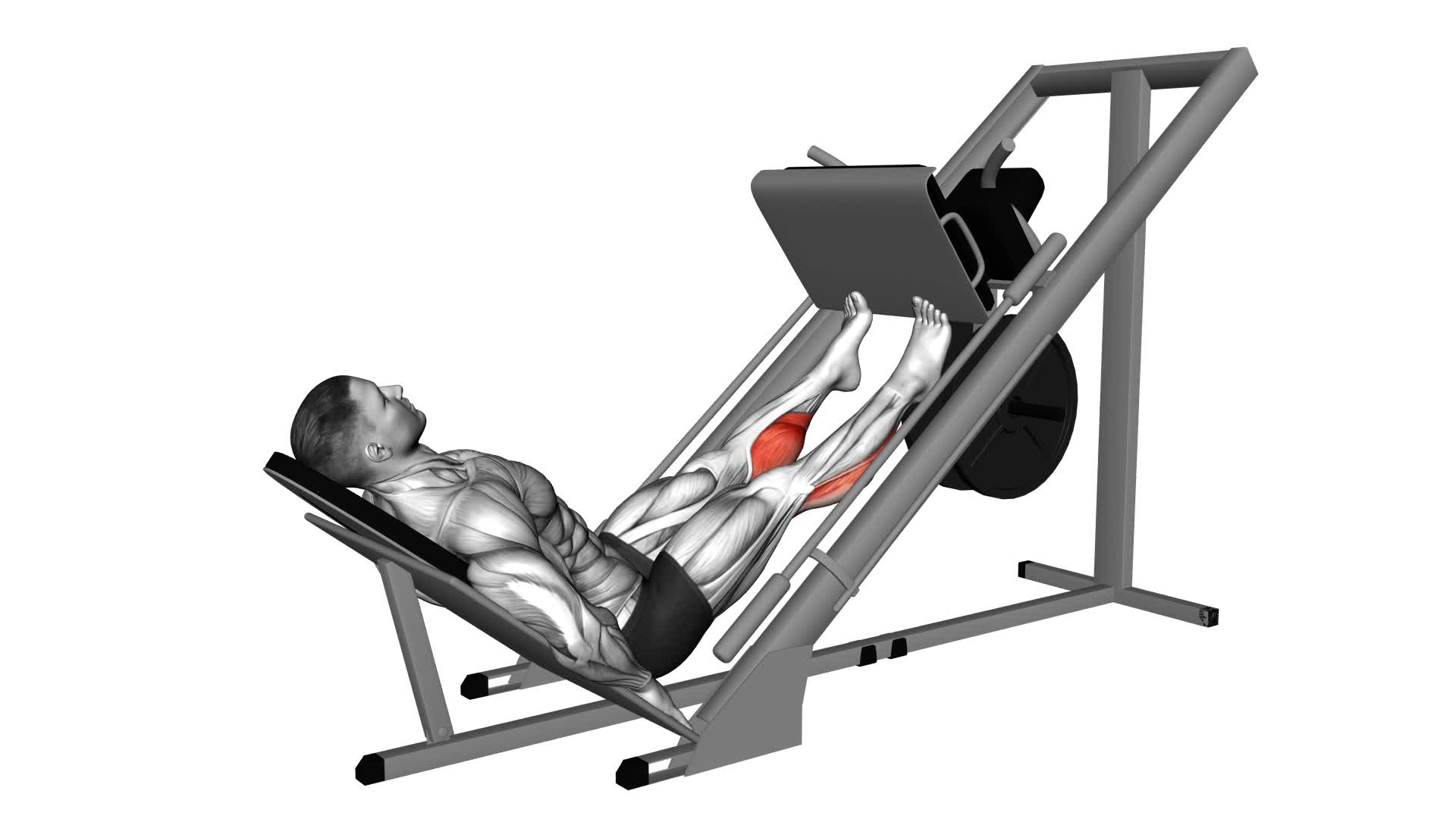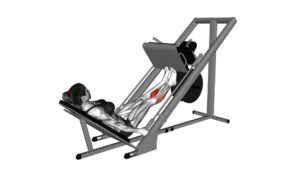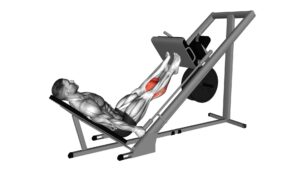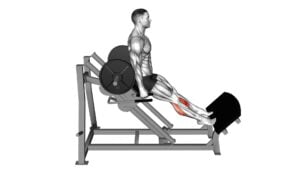Sled Calf Press On Leg Press – Video Exercise Guide & Tips

Are you looking for a way to strengthen your calf muscles? The sled calf press on the leg press machine is the exercise for you.
Watch This Exercise Video
In this video exercise guide, we will show you the proper technique and provide tips to help you get the most out of this exercise. Avoid common mistakes, increase intensity, and ensure your safety with our expert advice.
Get ready to power up your calf muscles with the sled calf press!
Key Takeaways
- Sled Calf Press is highly effective for calf muscle development and strength training.
- Proper set-up and machine adjustment are important for proper form and maximum muscle activation.
- The exercise works multiple muscle groups, including the lower legs, and can increase bone density.
- Avoid common mistakes such as improper foot placement and neglecting proper form to prevent injury and maximize results.
Benefits of the Sled Calf Press
What are the benefits of the sled calf press for you?
The sled calf press is a highly effective exercise for calf muscle development and calf strength training. By incorporating this exercise into your routine, you can expect to see significant improvements in both the size and strength of your calf muscles.
One of the key benefits of the sled calf press is its ability to target the calf muscles specifically. This exercise places a direct load on the calves, allowing for maximum muscle activation and stimulation. This targeted approach is essential for those looking to develop their calf muscles to their fullest potential.
Additionally, the sled calf press is a compound exercise, meaning it works multiple muscle groups at once. In addition to the calves, this exercise also engages the muscles of the lower legs, including the soleus and tibialis anterior. This leads to a more efficient and effective workout, as you're able to train multiple muscles simultaneously.
Furthermore, the sled calf press is a weight-bearing exercise, which helps to increase bone density and improve overall bone health. This is particularly beneficial for older individuals, as it can help prevent age-related bone loss and reduce the risk of osteoporosis.
Proper Set-Up and Machine Adjustment
To properly set up and adjust the machine for the sled calf press, you should begin by selecting an appropriate weight and positioning yourself on the leg press. Make sure the weight you choose allows you to perform the exercise with proper form and without straining.
Once you have selected the weight, position yourself on the leg press machine by sitting with your back against the padded backrest and placing your feet on the footplate. Adjust the seat so that your knees are slightly bent when your feet are on the footplate. This will ensure that you have a full range of motion during the exercise.
Next, adjust the foot placement on the footplate. Position your toes at the bottom of the footplate and keep your heels raised. This will allow you to engage your calf muscles effectively. Ensure that your feet are hip-width apart and parallel to each other. This alignment will help you maintain stability and target your calves properly.
Correct Technique for the Sled Calf Press
To perform the sled calf press with correct technique, start by positioning your feet on the footplate and ensuring that your toes are at the bottom and your heels are raised. This exercise primarily targets the calf muscles, helping to strengthen and tone them. The calf muscles play a crucial role in everyday activities such as walking, running, and jumping, so incorporating calf exercises into your workout routine can bring numerous benefits. Strong calf muscles can improve your balance, stability, and overall lower body strength.
There are several variations of calf exercises that you can try to target different areas of the calf muscles. For example, you can perform the seated calf raise using a machine or dumbbells, or you can do standing calf raises with or without weights. Each variation provides a slightly different stimulus to the calf muscles, allowing you to work them from different angles and maximize your overall calf development.
Common Mistakes to Avoid
When performing the sled calf press on the leg press machine, it's important to avoid common mistakes that can hinder your progress and potentially lead to injury.
One common mistake is improper foot placement, such as placing your feet too high or too low on the sled. This can put unnecessary strain on your calves and limit the effectiveness of the exercise.
Another mistake to avoid is neglecting proper form, such as not fully extending your ankles or using momentum to push the weight.
Improper Foot Placement
You should ensure that your foot placement is correct to avoid common mistakes during the sled calf press on the leg press exercise.
One common error is placing your feet too high on the sled platform. This can lead to excessive strain on your knees and lower back.
Another mistake is placing your feet too low, which reduces the effectiveness of the exercise and puts unnecessary pressure on your calves.
To avoid these errors, start by placing your feet shoulder-width apart and parallel to each other. Position your toes slightly below the middle of the sled platform. This allows for proper engagement of the calf muscles while maintaining stability and minimizing the risk of injury.
Neglecting Proper Form
To prevent injury and maximize the effectiveness of the sled calf press on the leg press exercise, it's important to avoid neglecting proper form and making common mistakes. Neglecting proper form can lead to strain or injury on your calves, hamstrings, or lower back.
One common mistake isn't warming up properly before starting the exercise. Warm-up exercises increase blood flow to the muscles, making them more flexible and less prone to injury. Additionally, stretching before the sled calf press can improve your range of motion and help you achieve a greater stretch on your calf muscles.
Tips for Increasing Intensity and Progression
To enhance the intensity and progression of your sled calf press on the leg press, incorporate advanced resistance techniques. Here are three tips to help you increase the resistance and apply progressive overload to your calf press workout:
- Adjust the weight: Start by increasing the weight on the leg press machine. Gradually add more weight as you become stronger, ensuring that it challenges your calf muscles without compromising your form.
- Vary the foot positioning: Experiment with different foot positions on the sled to target different areas of your calves. Try placing your toes on the sled for a greater emphasis on the soleus muscle, or position your heels on the sled to target the gastrocnemius muscle.
- Slow down the movement: Instead of rushing through the exercise, focus on controlling the movement and lowering the weight slowly. This increases the time under tension for your calf muscles, leading to greater muscle activation and growth.
Safety Precautions and Considerations
To ensure your safety during the sled calf press on leg press exercise, there are a few important points to consider.
Firstly, make sure you're using the equipment correctly, following the manufacturer's guidelines.
Secondly, employ injury prevention techniques such as maintaining proper form and using an appropriate weight for your fitness level.
Lastly, it's crucial to assess your fitness level before attempting this exercise to avoid any potential risks or injuries.
Proper Equipment Usage
Ensure your safety and maximize your workout by properly using the leg press equipment for the sled calf press exercise. Here are some important considerations:
- Adjust the seat position: Set the seat so that your knees are at a 90-degree angle when your feet are on the sled. This ensures proper alignment and reduces the risk of injury.
- Use appropriate weight: Start with a manageable weight and gradually increase as your strength improves. Avoid using excessive weight that could strain your calves or compromise your form.
- Maintain proper form: Keep your feet shoulder-width apart and press through your heels, not your toes. This targets the calf muscles more effectively and reduces stress on the knees.
Injury Prevention Techniques
When using the leg press equipment for the sled calf press exercise, prioritize injury prevention by implementing safety precautions and considering appropriate techniques. To prevent injuries, ensure that the leg press machine is properly set up and adjusted to your body proportions. Maintain proper form throughout the exercise by keeping your back flat against the seat, your feet shoulder-width apart, and your knees aligned with your toes.
It's important to start with a weight that's manageable for you and gradually increase the resistance as your calf muscles strengthen. Additionally, perform regular stretching techniques to improve flexibility and reduce the risk of muscle strains. By taking these precautions, you can minimize the chances of injury and safely strengthen your calf muscles.
Now, let's move on to the next section where we'll discuss how to assess your fitness level.
Fitness Level Assessment
How can you assess your fitness level while considering safety precautions and considerations?
Fitness assessment techniques are essential for determining your current level of fitness and identifying any potential risks or limitations. By conducting a thorough fitness assessment, you can better understand your body's capabilities and tailor your workout routine accordingly.
Here are three important considerations for fitness level assessment:
- Consult with a professional: Seek guidance from a qualified fitness professional who can perform a comprehensive fitness assessment and provide personalized recommendations based on your goals and current fitness level.
- Be mindful of your body: Pay attention to any pain, discomfort, or limitations during exercise. It's crucial to listen to your body and adjust your workout intensity or technique accordingly to prevent injuries.
- Use reliable fitness assessment tools: Utilize objective measures such as heart rate monitoring, body composition analysis, and strength tests to track your progress and make informed decisions about your fitness routine.
Frequently Asked Questions
Can the Sled Calf Press Exercise Be Done Without a Leg Press Machine?
Yes, you can do the sled calf press exercise without a leg press machine. There are alternative ways to work on your calf strength and perform calf exercises.
For example, you can use dumbbells or a barbell to do standing calf raises or seated calf raises. These exercises target your calf muscles and help improve their strength and definition.
Remember to start with appropriate weights and maintain proper form to avoid injury.
How Often Should I Incorporate the Sled Calf Press Into My Leg Workout Routine?
To effectively incorporate the sled calf press into your leg workout routine, consider the benefits it brings.
This exercise targets your calf muscles, helping to strengthen and tone them.
It can be done using a leg press machine or other equipment.
Aim to perform the sled calf press two to three times a week, with proper form and gradually increasing the weight.
Remember to listen to your body and adjust the frequency based on your individual fitness level and goals.
What Are Some Alternative Exercises That Can Target the Calf Muscles?
Looking for alternative exercises to target your calf muscles? There are several effective calf workouts you can try.
One option is standing calf raises, where you lift your body onto your toes and lower back down.
Another exercise is seated calf raises, which involves sitting and lifting your heels off the ground.
Don't forget about calf raises on a step or using a resistance band for added challenge.
Mix it up to keep your calves engaged and growing.
Are There Any Specific Recommendations for Individuals With Pre-Existing Calf Injuries or Conditions?
When it comes to managing calf injuries and conditions, there are some recommended modifications you can make to your exercise routine.
It's important to listen to your body and not push yourself too hard. Avoid exercises that put excessive strain on the calf muscles, and instead focus on low-impact activities like swimming or cycling.
It may also be beneficial to work with a physical therapist who can provide specific exercises to help strengthen and rehabilitate your calf muscles.
How Long Should I Hold the Contraction at the Top of the Sled Calf Press Movement for Maximum Benefit?
To get the maximum benefit from the sled calf press, it's important to know how long to hold the contraction at the top.
The optimal contraction duration for calf muscle activation varies from person to person. It's recommended to hold the contraction at the top for at least 1-2 seconds.
This allows for proper engagement of the calf muscles and helps to build strength and endurance.
Remember to listen to your body and adjust the duration as needed.
Conclusion
In conclusion, the sled calf press is an effective exercise for strengthening and toning the calves. By following the proper set-up and technique, you can maximize your results and avoid common mistakes.
It's important to gradually increase intensity and progression for continued improvement. Lastly, always prioritize safety by using the machine correctly and listening to your body's limits.
Incorporate the sled calf press into your leg workout routine for stronger and more defined calves.

Author
Years ago, the spark of my life’s passion ignited in my mind the moment I stepped into the local gym for the first time. The inaugural bead of perspiration, the initial endeavor, the very first surge of endorphins, and a sense of pride that washed over me post-workout marked the beginning of my deep-seated interest in strength sports, fitness, and sports nutrition. This very curiosity blossomed rapidly into a profound fascination, propelling me to earn a Master’s degree in Physical Education from the Academy of Physical Education in Krakow, followed by a Sports Manager diploma from the Jagiellonian University. My journey of growth led me to gain more specialized qualifications, such as being a certified personal trainer with a focus on sports dietetics, a lifeguard, and an instructor for wellness and corrective gymnastics. Theoretical knowledge paired seamlessly with practical experience, reinforcing my belief that the transformation of individuals under my guidance was also a reflection of my personal growth. This belief holds true even today. Each day, I strive to push the boundaries and explore new realms. These realms gently elevate me to greater heights. The unique combination of passion for my field and the continuous quest for growth fuels my drive to break new ground.







